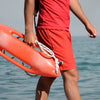Top 4 Must-Have Essential Equipment for Lifeguards
Introduction:
Lifeguards are the vigilant guardians of water safety, entrusted with the crucial task of ensuring the well-being of swimmers. To effectively fulfill this responsibility, lifeguards rely on essential equipment designed to aid in surveillance, rescue, and emergency response. In this blog post, we’ll highlight the top four lifeguard equipment essentials that every aquatic facility must have to enhance safety and preparedness.
1. Rescue Tubes:
A lifeguard’s most essential tool, the rescue tube, is a flotation device that serves as a lifeline during water rescues. Made from durable materials such as vinyl or foam, rescue tubes provide buoyancy for both the rescuer and the victim, facilitating safe and swift rescue operations. With bright colors and high visibility, rescue tubes also serve as visual aids, helping lifeguards locate distressed swimmers in crowded or turbulent waters. These indispensable devices are the backbone of every lifeguard’s rescue toolkit.
2. Lifeguard Whistles:
Lifeguard whistles are indispensable communication tools that enable lifeguards to signal emergencies, issue instructions, and maintain order in aquatic environments. The sharp, piercing sound of a whistle cuts through ambient noise, alerting swimmers and fellow lifeguards to potential hazards or distress signals. Lifeguard whistles are equipped with standardized codes for different situations, allowing lifeguards to effectively coordinate rescue efforts and enforce safety protocols. These simple yet powerful devices are essential for ensuring swift and organized responses to emergencies.
3. Spine Boards:
In cases of suspected spinal injuries, spine boards are essential for immobilizing and safely transporting injured swimmers. These rigid boards provide a stable platform for securing the victim’s spine, minimizing the risk of further injury during rescue and transit. Constructed from lightweight yet durable materials such as plastic or fiberglass, spine boards are designed to float, making them ideal for water rescue operations. Equipped with secure straps and handles, lifeguards can safely extract and transport injured individuals to medical facilities for further evaluation and treatment.
4. First Aid Kits:
Quick access to first aid supplies is essential for addressing minor injuries and providing immediate care during emergencies. Lifeguard first aid kits should contain essential items such as bandages, gauze pads, antiseptic wipes, adhesive tape, scissors, and CPR masks. Regular inspection and replenishment of first aid kits ensure that lifeguards have the necessary resources to respond effectively to medical emergencies and provide timely assistance to injured patrons. These kits are indispensable for maintaining the health and well-being of both swimmers and lifeguards alike.
Conclusion:
By equipping lifeguards with the top four lifeguard equipment essentials, aquatic facilities can enhance their safety protocols and response capabilities, ultimately creating a safer environment for swimmers and patrons. From rescue tubes and lifeguard whistles to spine boards and first aid kits, each piece of equipment plays a vital role in safeguarding lives and ensuring the well-being of all individuals enjoying aquatic activities. Prioritizing the provision and maintenance of these essential tools demonstrates a commitment to water safety and the peace of mind of everyone involved.
- Posted in First Aid Kit, Lifeguard Equipment, Lifeguard Rescue Equipment, Lifeguard Rescue Tube, Lifeguard Store, Lifeguard Tube, Lifeguard Whistle

